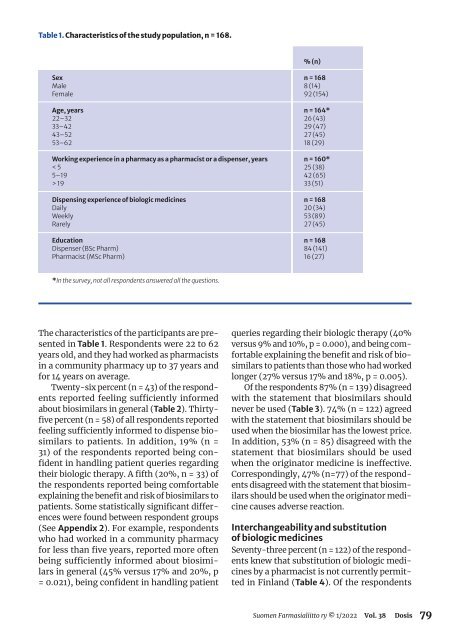DOSIS 1/2022
Farmaseuttinen aikakauskirja DOSIS 4/2021 vol.37 5uomen Farmasialiitto ry
Farmaseuttinen aikakauskirja DOSIS 4/2021 vol.37 5uomen Farmasialiitto ry
You also want an ePaper? Increase the reach of your titles
YUMPU automatically turns print PDFs into web optimized ePapers that Google loves.
Table 1. Characteristics of the study population, n = 168.<br />
% (n)<br />
Sex<br />
Male<br />
Female<br />
Age, years<br />
22–32<br />
33–42<br />
43–52<br />
53–62<br />
Working experience in a pharmacy as a pharmacist or a dispenser, years<br />
< 5<br />
5–19<br />
> 19<br />
Dispensing experience of biologic medicines<br />
Daily<br />
Weekly<br />
Rarely<br />
Education<br />
Dispenser (BSc Pharm)<br />
Pharmacist (MSc Pharm)<br />
n = 168<br />
8 (14)<br />
92 (154)<br />
n = 164*<br />
26 (43)<br />
29 (47)<br />
27 (45)<br />
18 (29)<br />
n = 160*<br />
25 (38)<br />
42 (65)<br />
33 (51)<br />
n = 168<br />
20 (34)<br />
53 (89)<br />
27 (45)<br />
n = 168<br />
84 (141)<br />
16 (27)<br />
*In the survey, not all respondents answered all the questions.<br />
The characteristics of the participants are presented<br />
in Table 1. Respondents were 22 to 62<br />
years old, and they had worked as pharmacists<br />
in a community pharmacy up to 37 years and<br />
for 14 years on average.<br />
Twenty-six percent (n = 43) of the respondents<br />
reported feeling sufficiently informed<br />
about biosimilars in general (Table 2). Thirtyfive<br />
percent (n = 58) of all respondents reported<br />
feeling sufficiently informed to dispense biosimilars<br />
to patients. In addition, 19% (n =<br />
31) of the respondents reported being confident<br />
in handling patient queries regarding<br />
their biologic therapy. A fifth (20%, n = 33) of<br />
the respondents reported being comfortable<br />
explaining the benefit and risk of biosimilars to<br />
patients. Some statistically significant differences<br />
were found between respondent groups<br />
(See Appendix 2). For example, respondents<br />
who had worked in a community pharmacy<br />
for less than five years, reported more often<br />
being sufficiently informed about biosimilars<br />
in general (45% versus 17% and 20%, p<br />
= 0.021), being confident in handling patient<br />
queries regarding their biologic therapy (40%<br />
versus 9% and 10%, p = 0.000), and being comfortable<br />
explaining the benefit and risk of biosimilars<br />
to patients than those who had worked<br />
longer (27% versus 17% and 18%, p = 0.005).<br />
Of the respondents 87% (n = 139) disagreed<br />
with the statement that biosimilars should<br />
never be used (Table 3). 74% (n = 122) agreed<br />
with the statement that biosimilars should be<br />
used when the biosimilar has the lowest price.<br />
In addition, 53% (n = 85) disagreed with the<br />
statement that biosimilars should be used<br />
when the originator medicine is ineffective.<br />
Correspondingly, 47% (n=77) of the respondents<br />
disagreed with the statement that biosimilars<br />
should be used when the originator medicine<br />
causes adverse reaction.<br />
Interchangeability and substitution<br />
of biologic medicines<br />
Seventy-three percent (n = 122) of the respondents<br />
knew that substitution of biologic medicines<br />
by a pharmacist is not currently permitted<br />
in Finland (Table 4). Of the respondents<br />
Suomen Farmasialiitto ry © 1/<strong>2022</strong> Vol. 38 Dosis 79

















